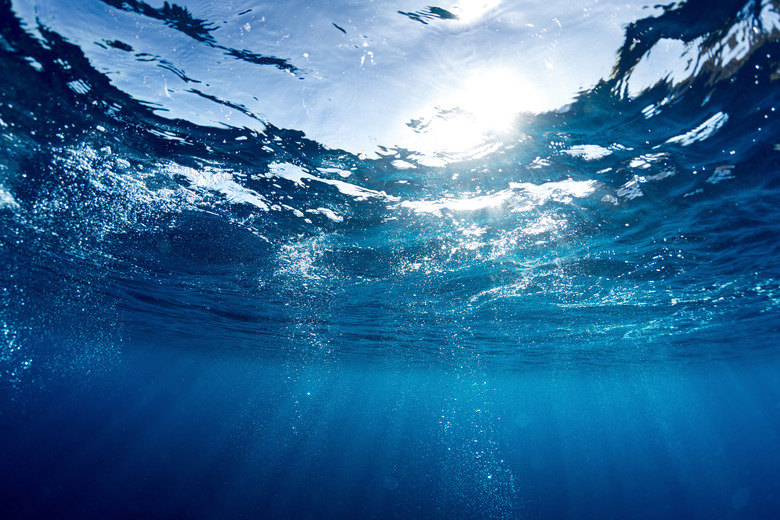3 Major Ocean Zones
The world ocean accounts for the majority of Earth's surface, yet is the least-known of its domains. It's an enormous watery wilderness from which all life emerged, but which is now mostly inhospitable to human beings. It's no surprise, given it's size, that the marine world encompasses an enormous variety of ecosystems, from vibrant coral reefs and shark-haunted kelp forests, to desolate abyssal plains and gaping submarine canyons. Oceanographers commonly partition the ocean into five zones, which can roughly be divided into three basic realms.
TL;DR (Too Long; Didn't Read)
The three ocean zones, in order of depth, are the surface, middle realm and deep realm.
Surface
Surface
The surface realm of the ocean is that is infiltrated — to ever-lessening degrees with depth — by sunlight. To a depth of 200 meters (660 feet) is the epipelagic — sunlight — zone, which also corresponds to the "photic zone" — that portion of the ocean where light is sufficient for the process of photosynthesis. From 200 to 1,000 meters (660 to 3,300 feet) is the mesopelagic or twilight zone, which defines the roof of the "aphotic" zone of minimal or absent sunlight. Temperature is variable in the sunlight zone, with convective heat being thoroughly mixed through the influence of wind on the ocean surface. A steep plunge in temperature with depth — the thermocline — defines the twilight zone.
Middle Realm
Middle Realm
The huge bathypelagic zone stretches from 1,000 to 4,000 meters (3,300 to 13,100 feet) deep, a reach so black it's also called the midnight zone. Well beyond the zone of shallow-water mixing, the midnight zone enjoys a constant temperature of about 4 degrees Celsius. The pressure of all that overlying water reaches better than 4,113,000 kilograms of force per square meter (5,850 pounds per square inch) at the lower margin of the midnight zone.
Deep Realm
Deep Realm
The two deepest realms of the ocean are almost unimaginably remote and shrouded. The abyssopelagic zone — the abyss — stretches from 4,000 to 6,000 meters (13,100 to 19,700 feet), which brings it down to the ocean floor across much of Earth's surface. In the submarine trenches, however, the hadalpelagic zone plunges deeper yet — down to 10,911 meters (35,797 feet) in the Challenger Deep of the Marianas Trench in the western Pacific.
Zonal Ecosystems
Zonal Ecosystems
Every zone in the ocean harbors life, though its distribution is quite skewed. Shallow coastal waters can be highly productive, inundated as they are with plentiful sunlight that nurtures photosynthetic plants and plankton. By contrast, the ocean floor in the abyssal and trench reaches can seem lifeless, though impressively diverse communities of unique benthic organisms, from huge worms to clams, are associated with hydrothermal vents. Certain creatures regularly cross the thresholds between the ocean's vertical realms. Organisms from zooplankton to robust predatory squid may daily migrate from dim mesopelagic depths to surface waters for nocturnal feeding. Some specialized marine mammals, such as sperm whales, beaked whales and elephant seals, will dive to great depths. Sperm whales have been recorded at 2,800 meters (9,186 feet) on the hunt for squid and other deep-water prey.
References
- National Oceanic and Atmospheric Administration: JetStream – Layers of the Ocean
- Oceanography; M. Grant Goss
- Encyclopedia of Earth: Mesopelagic Zone
- The Sierra Club Handbook of Whales and Dolphins; Stephen Leatherwood, Randall R. Reeves
Cite This Article
MLA
Shaw, Ethan. "3 Major Ocean Zones" sciencing.com, https://www.sciencing.com/3-major-ocean-zones-22658/. 19 April 2018.
APA
Shaw, Ethan. (2018, April 19). 3 Major Ocean Zones. sciencing.com. Retrieved from https://www.sciencing.com/3-major-ocean-zones-22658/
Chicago
Shaw, Ethan. 3 Major Ocean Zones last modified March 24, 2022. https://www.sciencing.com/3-major-ocean-zones-22658/
